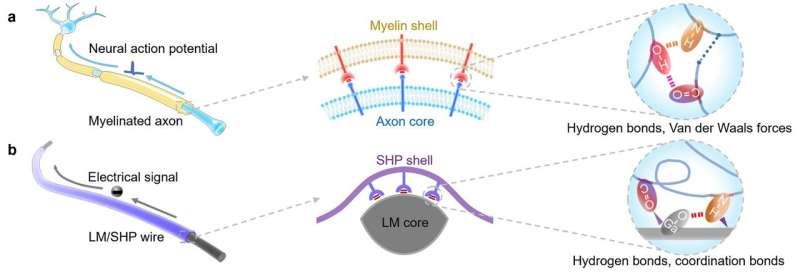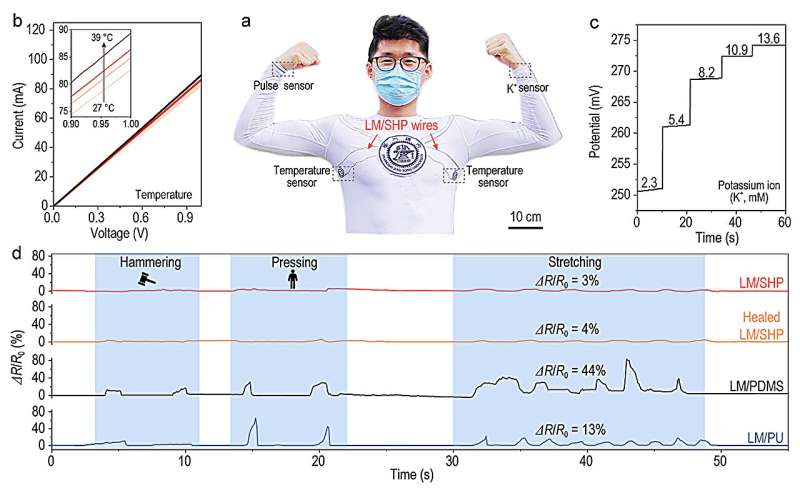This article has been reviewed according to Science X's editorial process and policies. Editors have highlighted the following attributes while ensuring the content's credibility:
fact-checked
trusted source
proofread
A dynamically stable self-healable wire based on mechanical–electrical coupling

Highly flexible and conductive wires play a crucial role in integration and application of wearable devices. However, the frequent stress and deformation in practical use are prone to cause structural damage to these wires, leading to failure of the entire module. Self-healable wires are capable of recovering the mechanical and electrical properties when encountering structure damage, which offers a promising solution to this issue.
However, the practical applications of self-healable wires are hindered by the highly fluctuating electrical resistance under dynamic conditions such as bending, pressing, stretching, and tremoring, which significantly reduces the continuous monitoring accuracy of the interconnected wearable devices.
To overcome these bottlenecks, a research team led by Prof. Hao Sun from Shanghai Jiao Tong University has developed a novel family of dynamically stable self-healable wires based on mechanical-electrical coupling, which was inspired by the hydrogen bonds and van der Waals forces interaction between axon core and myelin shell in myelinated axon. The team employed supramolecular chemistry to improve the tensile strength (35–73 MPa) of the self-healable wires, which showed good match with common textile fibers (28–74 MPa).
More importantly, the mechanical-electrical coupling effect based on hydrogen and coordination bonds between the structural (self-healable polymer) and conductive (GaInSn liquid metal) components had significantly enhanced the electrical stability of the self-healable wires under various dynamic environments. For example, the resistance change of these self-healable wires was less than 0.7 ohms at a high strain of 500%, and the electrical resistance was increased by less than 5% under various dynamic conditions such as bending, pressing, knotting, and washing.

These wires show promise for wearable applications due to their excellent mechanical, electrical, and dynamic properties. For instance, an integrated health care platform could be fabricated consisting of temperature, pulse, and K+ sensors, microcontroller unit, Bluetooth module, and lithium-ion battery, which were interconnected using these self-healable wires, which showed negligible electrical resistance fluctuation of 3–4% under hammering, pressing, and stretching, even after breaking and healing.
In addition, it allowed stable and accurate monitoring of human activities, even under the scenario of limb tremor caused by simulated Parkinson's disease. These results showed the importance of high dynamic stability of self-healable wires which ensured reliable operation of the interconnected wearable devices.
"We need self-healable wires that can maintain their electrical resistance under dynamic conditions, which is key to ensuring the precision and reliability of the interconnected wearable devices in practical applications. In our attempts to achieve this goal, we notice that the nervous system can reliably transmit neural action potentials even under severe deformations, which inspires us to propose the 'mechanical-electrical coupling' mechanism, focusing on enhancement of interfacial interaction.
"We therefore innovate self-healable polymer materials via supramolecular chemistry to induce strong interaction with GaInSn liquid metal, thus achieving dynamically stable self-healable wires that benefit practical wearable scenarios," Prof. Hao Sun said.
"In a broader perspective, our 'mechanical-electrical coupling' can become a general strategy to improve the dynamic stability of various flexible materials and devices, and benefit a variety of applications such as wearable health care, intelligent robotics, and implantable electronics."
More information: Shuo Wang et al, A dynamically stable self-healable wire based on mechanical–electrical coupling, National Science Review (2024). DOI: 10.1093/nsr/nwae006
Provided by Science China Press





















